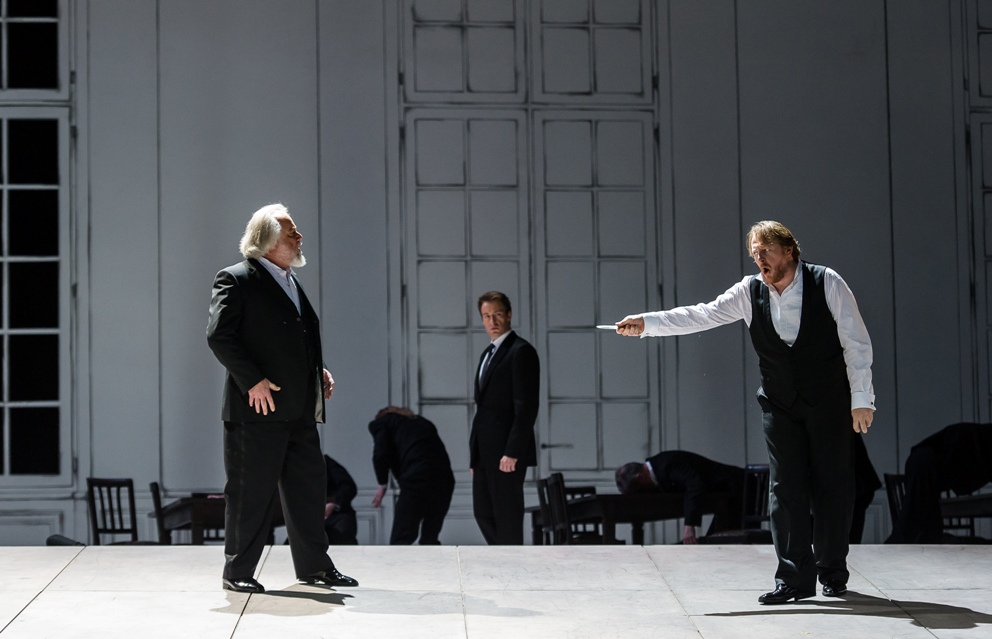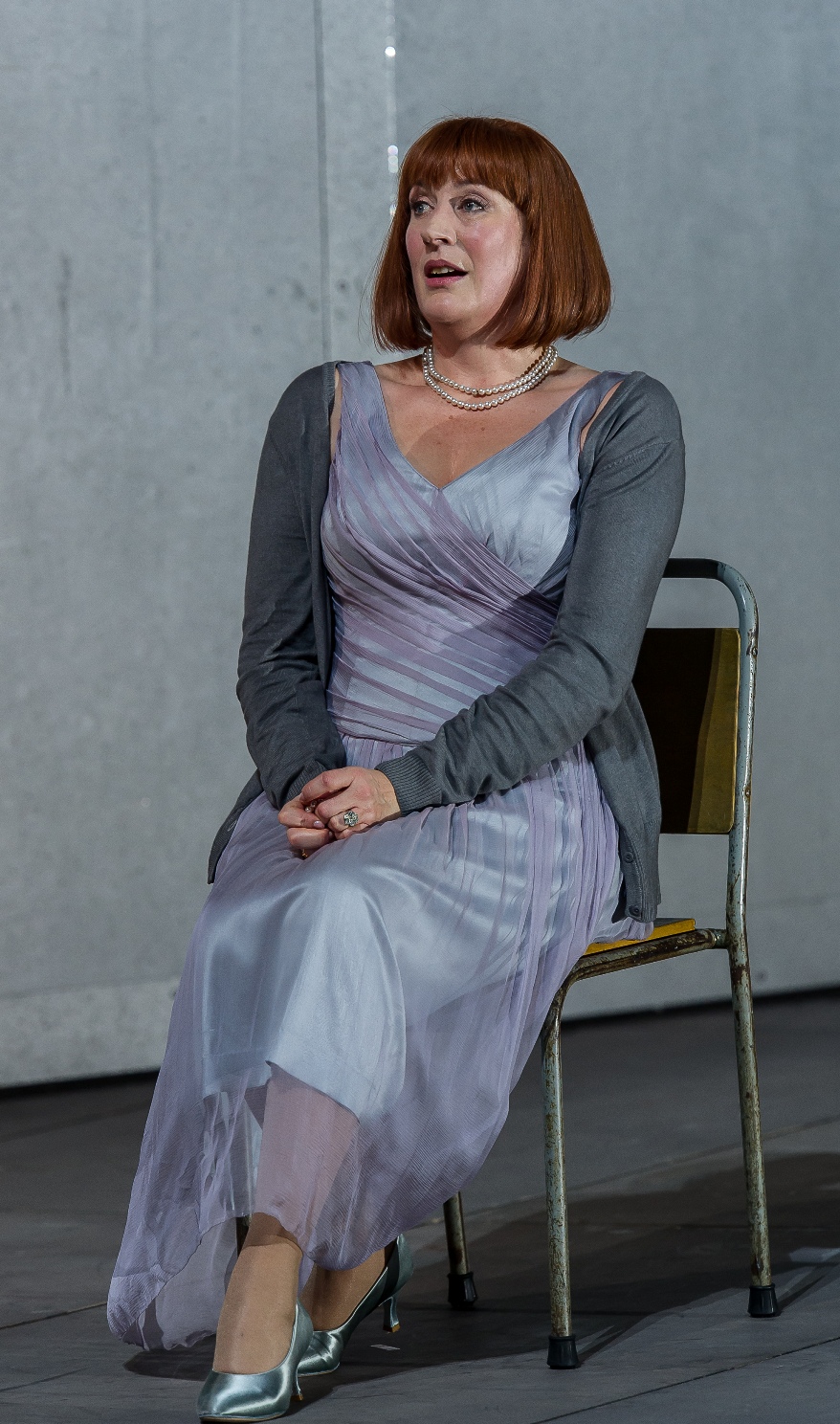Tristan und Isolde, Royal Opera | reviews, news & interviews
Tristan und Isolde, Royal Opera
Tristan und Isolde, Royal Opera
Antonio Pappano and Nina Stemme spellbind again in Christof Loy's rigorous Wagner

Eternal love is in the air, not seasonal fluff, at the Royal Opera this December. Later in the month Verdi’s most ecstatic duet, in Un ballo in maschera, will find his Riccardo and Amelia briefly playing Tristan and Isolde, very much in the shadow of not so much the greatest as the strangest love story ever told.
The lovers are together then, but they spend the outer acts mostly apart, in their own personal hells. It’s vital that the soprano and tenor are equally matched, but given the insane vocal demands, they rarely are both musically and dramatically, and that’s unfortunately, if not fatally, the case here: while Stephen Gould barely scratches the surface of Tristan’s existential angst in the longest of all operatic monologues, Nina Stemme earlier runs the gamut from blind fury to nostalgic tenderness with astonishing commitment and intelligence. Her top is flawlessly full and luminous; Gould’s isn’t, not now at any rate, and he doesn’t really act with the voice, but he makes a fine impression in mid-range and at mezzo-forte or softer, and ultimately he can sing Tristan, which is more than has been said for many who’ve tried.
This is Stemme’s year, maybe not from her perspective where it may well be superhuman business as usual, but certainly from mine, since I didn’t catch Loy’s production back in 2009 and only saw the first half of the Proms Ring in which, by the end of Götterdämmerung, Stemme had made history. She made it again with the concert Salome this August, and now she sets her seal on being the most secure and dramatically imaginative Isolde of our time. Loy’s ploy, on an open space devoid of everything but first one, then two chairs and a table, is to make his lovers deeply human. Maybe Wagner’s aren’t, and perhaps we don’t want to see preparations for a kitchen supper while transcendental questions are being debated, but from the start, when we see Stemme’s Isolde trying to contain her agony and hurt alone on the bare stage, we believe.
 As with the acting Sellars gets from his singers in The Gospel According to the Other Mary, Stemme realizes Loy’s vision to the extent that the slightest angle of the body tells us everything we need to know. There’s an extraordinary scene in Act Two when, having raised the curtain on King Marke’s frigid dining-room space at the back, an exclusively male world, to shed light for Tristan and presumably to get him to tell the truth to the man he forced her to marry, she’s set up the chairs for a debate between the betrayed and betrayer, then goes and sits right at the back of the dining-room. We know from the tilt of her head how she expects Tristan to speak and how frustrated she is when he stays silent. All this was absolutely clear from the back of the balcony.
As with the acting Sellars gets from his singers in The Gospel According to the Other Mary, Stemme realizes Loy’s vision to the extent that the slightest angle of the body tells us everything we need to know. There’s an extraordinary scene in Act Two when, having raised the curtain on King Marke’s frigid dining-room space at the back, an exclusively male world, to shed light for Tristan and presumably to get him to tell the truth to the man he forced her to marry, she’s set up the chairs for a debate between the betrayed and betrayer, then goes and sits right at the back of the dining-room. We know from the tilt of her head how she expects Tristan to speak and how frustrated she is when he stays silent. All this was absolutely clear from the back of the balcony.
Even the haters of this production, and they seem to be legion, couldn’t fault what Loy finds between the polarities of night and day so central to the opera, and the way his protagonists hover between the two. I’d argue that Johannes Leicker’s spare designs and Olaf Winter’s often spectral lighting are perfect to underline the contrasts, too. I gather that the wall stage right has been adjusted so more in the audience can see it (there were empty seats on the left of the auditorium which had apparently been withheld from sale). They must, because every one of the characters stands revealed against it at one time or another. That this is a true ensemble is underlined when John Tomlinson’s now gruffly sung but verbally and physically perfect Marke (pictured above with Iain Paterson's Kurwenal) arraigns the other five principals.
 Surely the opera has never had a better pair of servants. Sarah Connolly’s Brangäne (pictured left), rather fetching in a bob-cut orange wig and uncharacteristically subservient in demeanour though not of voice, has an even more lustrous middle range than Stemme, and inflects the text just as well; Iain Paterson as Kurwenal, her lover in the amazing night watch sequence, clearly has the stamina, physical poise and vocal focus for the role of Hans Sachs, which he’ll be singing at English National Opera next year.
Surely the opera has never had a better pair of servants. Sarah Connolly’s Brangäne (pictured left), rather fetching in a bob-cut orange wig and uncharacteristically subservient in demeanour though not of voice, has an even more lustrous middle range than Stemme, and inflects the text just as well; Iain Paterson as Kurwenal, her lover in the amazing night watch sequence, clearly has the stamina, physical poise and vocal focus for the role of Hans Sachs, which he’ll be singing at English National Opera next year.
The greatest beauty of all comes, as it must, from Antonio Pappano’s Royal Opera Orchestra. Pappano's reading of the score is now honed to the most exquisite soft playing in the time-suspended second act – strings barely murmuring, horns in supernatural hallowing – and the drive behind the initial thrill of the lovers’ meeting is beautifully balanced both within the orchestra and for the singers, Stemme’s ecstatic cries, top Cs and all, burning through the textures. No Tristan can ever be quite perfect in this world, and you just have to accept here that the hero’s agonies in Act Three aren’t going to work quite like the rest of the opera, but for those moments of bliss, this is rare perfection.
rating
Share this article
The future of Arts Journalism
You can stop theartsdesk.com closing!
We urgently need financing to survive. Our fundraising drive has thus far raised £49,000 but we need to reach £100,000 or we will be forced to close. Please contribute here: https://gofund.me/c3f6033d
And if you can forward this information to anyone who might assist, we’d be grateful.

Subscribe to theartsdesk.com
Thank you for continuing to read our work on theartsdesk.com. For unlimited access to every article in its entirety, including our archive of more than 15,000 pieces, we're asking for £5 per month or £40 per year. We feel it's a very good deal, and hope you do too.
To take a subscription now simply click here.
And if you're looking for that extra gift for a friend or family member, why not treat them to a theartsdesk.com gift subscription?
more Opera
 Le nozze di Figaro, Glyndebourne review - perceptive humanity in period setting
Mostly glorious cast, sharp ideas, fussy conducting
Le nozze di Figaro, Glyndebourne review - perceptive humanity in period setting
Mostly glorious cast, sharp ideas, fussy conducting
 Fidelio, Garsington Opera review - a battle of sunshine and shadows
Intimacy yields to spectacle as Beethoven's light of freedom triumphs
Fidelio, Garsington Opera review - a battle of sunshine and shadows
Intimacy yields to spectacle as Beethoven's light of freedom triumphs
 Dangerous Matter, RNCM, Manchester review - opera meets science in an 18th century tale
Big doses of history and didaction are injected into 50 minutes of music theatre
Dangerous Matter, RNCM, Manchester review - opera meets science in an 18th century tale
Big doses of history and didaction are injected into 50 minutes of music theatre
 Mazeppa, Grange Park Opera review - a gripping reassessment
Unbalanced drama with a powerful core, uninhibitedly staged
Mazeppa, Grange Park Opera review - a gripping reassessment
Unbalanced drama with a powerful core, uninhibitedly staged
 Saul, Glyndebourne review - playful, visually ravishing descent into darkness
Ten years after it first opened Barrie Kosky's production still packs a hefty punch
Saul, Glyndebourne review - playful, visually ravishing descent into darkness
Ten years after it first opened Barrie Kosky's production still packs a hefty punch
 Così fan tutte, Nevill Holt Festival/Opera North review - re-writing the script
Real feeling turns the tables on stage artifice in Mozart that charms, and moves
Così fan tutte, Nevill Holt Festival/Opera North review - re-writing the script
Real feeling turns the tables on stage artifice in Mozart that charms, and moves
 La Straniera, Chelsea Opera Group, Barlow, Cadogan Hall review - diva power saves minor Bellini
Australian soprano Helena Dix is honoured by fine fellow singers, but not her conductor
La Straniera, Chelsea Opera Group, Barlow, Cadogan Hall review - diva power saves minor Bellini
Australian soprano Helena Dix is honoured by fine fellow singers, but not her conductor
 The Queen of Spades, Garsington Opera review - sonorous gliding over a heart of darkness
Striking design and clear concept, but the intensity within comes and goes
The Queen of Spades, Garsington Opera review - sonorous gliding over a heart of darkness
Striking design and clear concept, but the intensity within comes and goes
 The Flying Dutchman, Opera Holland Park review - into the storm of dreams
A well-skippered Wagnerian voyage between fantasy and realism
The Flying Dutchman, Opera Holland Park review - into the storm of dreams
A well-skippered Wagnerian voyage between fantasy and realism
 Il Trittico, Opéra de Paris review - reordered Puccini works for a phenomenal singing actor
Asmik Grigorian takes all three soprano leads in a near-perfect ensemble
Il Trittico, Opéra de Paris review - reordered Puccini works for a phenomenal singing actor
Asmik Grigorian takes all three soprano leads in a near-perfect ensemble
 Faust, Royal Opera review - pure theatre in this solid revival
A Faust that smuggles its damnation under theatrical spectacle and excess
Faust, Royal Opera review - pure theatre in this solid revival
A Faust that smuggles its damnation under theatrical spectacle and excess
 Pygmalion, Early Opera Company, Curnyn, Middle Temple Hall review - Rameau magic outside the opera house
Welcome opportunity to catch opera-ballet, though not everything is in perfect focus
Pygmalion, Early Opera Company, Curnyn, Middle Temple Hall review - Rameau magic outside the opera house
Welcome opportunity to catch opera-ballet, though not everything is in perfect focus

Add comment